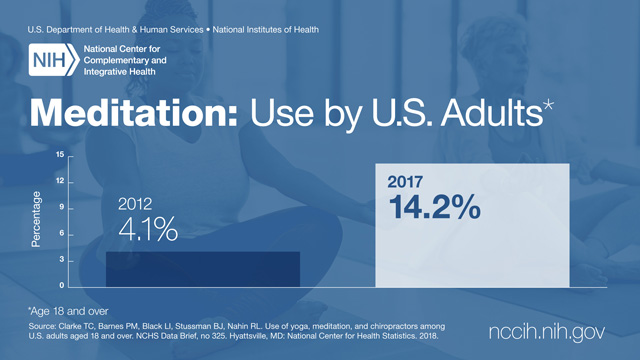Exploring Meditation

(Faye Cornish)
By Valeria Martinez
Breathe in, hold for 10 seconds, breathe out. Now get into the position of downward dog.
This is what usually comes to mind if someone were to say to you, I meditate. However, there are different ways to meditate. Most people do it for their health or as a way to relax after a long day. According to the National Center for Complementary and Integrative Health, a study done in 2017 found that U.S. adults’ use of meditation tripled between 2012 and 2017 and it showed that children aged 4 to 17 years also increased from 0.6% to 5.4%.
There is solid evidence that shows meditation can improve physical and mental health. Meditation is a practice that anyone can do in order to train their mind, their awareness, and their attention skills. It’s been around since the 12th century and many cultures and have since adapted it into their lifestyles.

Different types of meditation have disparate goals. In “A Guide to Seven Different Types of Meditation,” Everyday Health summarizes seven types of meditation: Mindfulness, Transcendental, Guided, Vipassana, Loving Kindness/Metta, Chakra, and Yoga.
Mindfulness meditation can help people who struggle with pain and has also been shown to help with anxiety, depression, and insomnia.
When meditation is routinely done, it can change the brain and the body. According to Psych Central’s “How Meditation Changes the Brain,” research has shown that meditation can change the brain’s structure and its function. The three areas where you can measure the effects are the prefrontal cortex, which is responsible for decision making, the amygdala, which controls emotional response and the hippocampus, which is responsible for memory and learning.

“Meditation changes the way your brain responds to distractions,” say the article’s author Lela Moore. “When you can focus entirely on the present and train yourself to do so consistently, the structure of your brain actually changes.” By meditating as we grow older, we can slow down our aging brain, according to a 2015 article in Frontiers of Psychology. She explains it might preserve the brain’s gray matter, which controls how fast we process information, and meditation could stall or even reverse aging.
Some of the excuses people offer for not wanting to try out meditating are: “I don’t have time to meditate,” “It’s too hard to not think about anything,” “I’m not going to get anything out of it,” or “I’m not a spiritual person so it won’t work.”
If you don’t have time throughout the day, maybe you could meditate for five minutes instead of going on social media or watching tv. It can be an alternative to those things, and you’ll be more relaxed when you come out of it. As for the second excuse, when you first try meditating, it can be hard to focus but practice makes perfect. Devote at least five minutes every day to get in the right head space and you’ll notice that you get better over time, and you can do it for longer than five minutes.
Although you might not learn anything from meditating, you come out of it relaxed. While meditating if there are reoccurring thoughts popping up, you can take note of them and see that maybe you should focus on those problems in your life a bit more, so they don’t bother you as much. Lastly, you don’t have to be spiritual to meditate. You can meditate as a way to exercise your mind, the idea that it’s a spiritual thing comes from the cultures that practice it. Additionally, there are different types of meditation. If one type has things, you’re not fond of like mantras, you simply move onto the another.

Sahaja Yoga is a calming meditation that is offered through a zoom meeting. Shri Mataji Nirmala Devi founded Sahaja Yoga in 1970 in India and it’s now practiced in over 100 countries. It consists of channeling ‘Kundalini energy’ and focuses on seven energy centers, also known as chakras, throughout the body. There are multiple steps but the instructors are there on the zoom helping you through the steps. This meditation helps me with freeing my mind of any current worries and stress that I have, and it helps me focus on the things I really need to focus on. They have a website for anyone who is interested, and I suggest trying it out and see if you’d like it.
